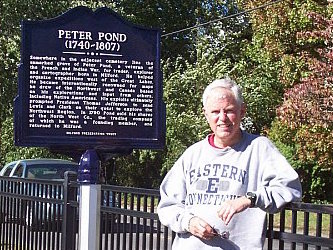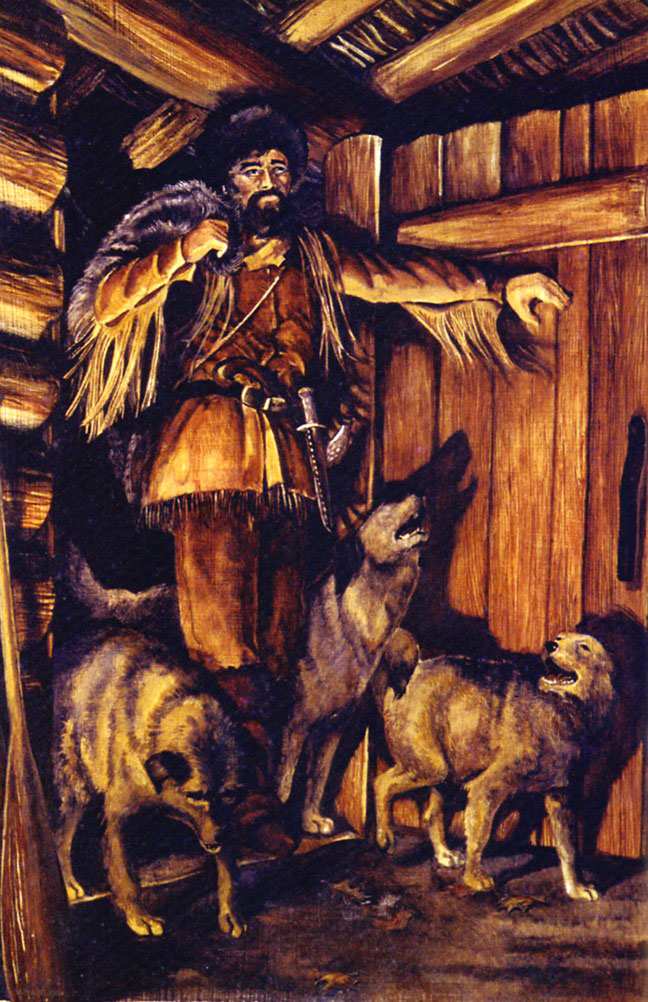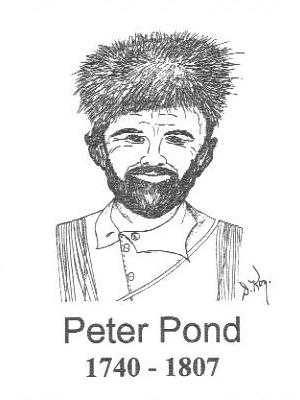Peter Pond newsletter :: MAY 2000 :: #1
Updating some of my earlier notations, several places in Canada commemorating Peter Pond no longer exist, at least temporarily. Here is a rundown:
CAIRN MOVED FROM RIVER
The cairn honoring Pond that sits along the North Branch of the Saskatchewan River outside of Prince Albert, SK has been removed. Why? Because the Batoche National Historic Site that oversees the area had to save it from the encroaching river. Someone I know in Prince Albert tipped me off, and I recently got confirmation from the Batoche official in the following email:
"Mr. McDonald,
The cairn was removed from the site last fall. Continual river erosion to the bank has resulted in a substantial loss of the site itself. Discussion with the City of Prince Albert to relocate the plaque commemorating Peter Pond have started.
Flo Miller
Site Manager, Batoche."
So, apparently the cairn itself is no longer, but the plaque will be relocated someplace else. I find this fascinating, since rivers have played such a big part in Pond's history. First, rivers are what conveyed him to this spot in the first place to trade with Indians, then pool goods amongst other traders and be the first white man over Methye Portage and into history in 1778. O.C. Furniss of University of Saskatchwan, when he found evidence of the Pond encampment in 1942 leading to a cairn being erected in 1950, did so with the river's help. Old narratives said Pond's house was on the Saskatchewan about 1/8 mile from the mouth of the Sturgeon River. When he first started looking 1/8 mile from the Sturgeon, he found nothing. But then from a plane he saw river action had placed the mouth of the Sturgeon at two different locations east of its current site over the years. So Furniss paced off from the most easterly former location and sure enough found what he was after. After digging three or four feet down, he found flat hearthstones arranged in semi-circular shape identical to other fireplaces of other old trading camps found in the past. Digging through a layer of old sandy silt showed this had been flooded before. And now, in the year 2000, the river was trying to reclaim the cairn itself. ("1943 notes on newly discovered fur posts on the Saskatchewan River," Canadian Historical Review.)
PETER POND SCHOOL
Sources in Fort McMurray, Alberta say the Peter Pond School is no longer there. It was closed and torn down about five years ago, replaced by small strip mall of several stores. No plans mentioned to build a new school or rename an existing one after him. The stone cairn by the school with a plaque honoring Pond as the first white man through the area followed by the likes of Sir Alexander Mackenzie, Sir John Franklin and Sir George Simpson (N.B. Pond was called &qout;Sir Peter&qout; in his declining days in Milford, but no evidence exists on an actual knighthood) was carefully moved a block down to in front of the public schools office. I hope the Prince Albert folks are careful, too. The hotel? The name has been changed from Peter Pond Hotel to Peter Pond Travelodge. But there still is a Peter Pond Shopping Center, so far.
PETER POND LAKE
Hope they still keep the lake in Saskatchewan south of Methye Portage named after him. It did have another name before getting his, that being Buffalo Lake or Lac du Boeuf. The town of Buffalo Narrows still exists on the lake, a nod to the previous name. Buffalo Narrows has a nice web site, noting the name comes from Indians driving buffalo into the lake to swim through the narrows where they could be easily slaughtered with spears and arrows. Buffalo horns and skulls still line the lake bottom in this area.
SEARCH FOR NEW LOCATION FOR CAIRN
This is the plaque (English and French text) set on a pyramid cairn just outside Prince Albert, SK, on the north branch of the Saskatchewan River. As of Summer 2000, city and federal federal officials were searching for a new site for the plaque due to river incursion. English text reads: &qout;Peter Pond, 1740-1807. In the spring of 1778 a group of Canadian traders who had wintered at a post on this site pooled their remaining stock of trade goods and sent one of their number, Peter Pond, into the Athabasca country, thereby opening one of the richest fur areas on the continent. Pond was one of the original partners of the North West Company until his implication in two murders forced him to withdraw from the trade and retire to his native Connecticut in 1790. His discoveries and geographical theories had a profound influence on the explorations of Alexander Mackenzie who succeeded him in Athabasca.&qout;
Pine Portage rapids on the lower Clearwater River, about a half day below Methye Portage. This is the second to last set of rapids, the last being Cascade, before the Clearwater becomes flat for another three days' paddle to Fort McMurray, Alberta, at the confluence of the Athabasca River.
WHITEMUD FALLS
Whitemud (Terre Blanche) Falls, three hours below Methye Portage on the lower Clearwater River. This is the first set of rapids after Methye, followed by Pine and Cascade, before the river flattens out for another 60 miles to the Athabasca River
A lone red canoe is virtually swallowed up by the wide, meandering expanse of the lower Clearwater Valley just below Methye Portage.
METHYE PASSAGE
The northern terminus of Methye Portage as mist lifts off green hills during a gentle rain. Peter Pond doubtless saw the same view in 1778 as the first white man to confront the Clearwater River.
A section Methye Portage has worn deep into the earth as it climbs the hill up to Mackenzie Viewpoint above the Clearwater River. The trail was the only fur trade access to the riches of the Athabasca District and Mackenzie River watershed for 100 years after Peter Pond first crossed it in 1778.
PETER POND MARKER IN MILFORD, CONNECTICUT
The only visible acknowledgement to Peter Pond in Milford, CT, the town where he was born and died, is on the nation's bicentennial marker on the town green. He is listed among other famous residents like Connecticut Governor Charles Hobby Pond and submarine inventor Simon Lake. Look closely and discern the words "explorer Peter Pond" on the third line from the bottom off to the right.
This plaque in Fort McMurray, Alberta, honoring Pond as the first white man across Methye Portage some 100 miles upriver can be clearly read. The plaque was moved in the mid 1990's from in front of the former Peter Pond School, demolished to be replaced by a small shopping center. The plaque and cairn now sit a few blocks away in front of the Board of Education building.
PETER POND PORTRAIT
A likeness of Peter Pond was never made in his lifetime. This illustration was done to accompany my article on Pond published in the March 1984 issue of "Canoe" Magazine. The artist is Illona Petrovitz Viehman, wife of the magazine's then editor, John Viehman, current editor of "Backpacker" Magazine. Interestingly, he and Michael Peake, editor of Che-Mun, took a canoe trip retracing part of Mackenzie's voyage to the Pacific, the subject of an "Anyplace Wild" Public Broadcasting System television program shown in the fall of 1999. Che-Mun, a quarterly newsletter of Canadian wilderness canoeing, is among my links.
A part of Mackenzie's portrait by Sir Thomas Lawrence, currently hanging in the National Gallery of Canada, as it was used in a pamphlet honoring him during the bicentennial observance of his successful 1793 voyage. This pamphlet commemorated the cross-Canada voyage done for the bicentennial over three years on the historic fur trade route by a group of students and faculty from Lakehead University, Thunder Bay, Ontario. They arrived at Mackenzie Rock on the Pacific Coast the exact July day he did 200 years before. I have a video tape of their voyage showing what they did was truly admirable.
SUGGESTIONS FOR NEWSLETTER NAME
That's about all for the first Peter Pond Society Newsletter. Not sure when the next one will come out -- whenever time and suitable material permit. Stay tuned. Would anyone like to think up a newsletter name in the meantime, e.g., "Call of the North" or "Le Clarion"? Email me your thoughts on this and any other Pond-related topics.

See you on the river
Au revoir,
Bill
website design by Daniel Ortoleva










